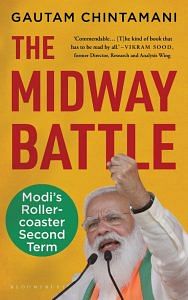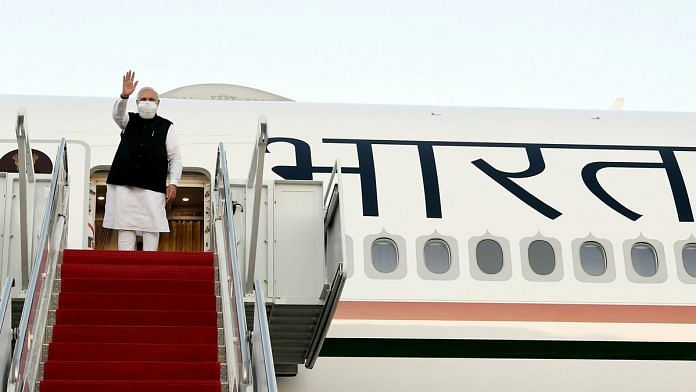In his first appearance at the UN, Modi stated in no uncertain terms that institutions that reflected the imperativeness of the 20th century would not be effective in the 21st. He also made it clear that India would no longer be an afterthought when it came to the world stage.
Between 2014 and 2019, India under Modi re-invented itself on the world diplomacy map. A perceptible difference between the Modi-led NDA government and UPA-I and UPA-II under Manmohan Singh was the manner in which India enhanced its clout as a major player in nearly every sphere as opposed to constricting itself. It had also created strategic alliances across the spectrum, and for the first time in decades, India struck a fine balance in keeping countries on its side. While negotiating with the outside world, the mantra was simple — this ‘new’ India was not going to be second to anyone. The best showcase of this new approach was most visible in the way India began dealing with oil imports. Through ‘oil diplomacy’ efforts focused on Russia, Latin America and Africa between 2014–18, India renegotiated supply contracts with countries that it bought oil from – it increased its investments in Russia to US$10 billion by buying oil fields in addition to its older investment in Sakhalin, it bought a 100 per cent stake in Abu Dhabi’s Onshore Block 1 Concession with plans to invest US$170 million, it furthered its investment in South Sudan and Mozambique, it engaged with both the US and Russia as part of its agenda to diversify from acute dependence on OPEC (Organization of Petroleum Exporting Countries) for energy sources.
India changed the rules of the game when it began to import crude oil from the US and the move sent a message to OPEC that the world’s third-largest consumer had other options. A common factor across most of the Modi government’s landmark achievements as far as foreign policy went was to get countries that ideally did not see eye-to-eye to sit on the same side of the table. India managed to do the near-impossible by getting other Asian giants such as China, Japan and South Korea to come onboard to push OPEC to treat Asian buyers as primary markets. With Petroleum Minister Dharmendra Pradhan raising the issue of OPEC charging Asian nations a premium for imported crude when compared with European and US importers, talks about China and India forming an oil buyers’ club were seen as the rise of a new cartel that could force OPEC to think of setting new and fair prices for Asian consumers.
Also read: Modi on Time 100 list for ‘Hindu nationalism, eroding Muslims’ rights, mishandling Covid’
The realization that India and China alone accounted for 17 per cent of the world’s oil consumption and India’s willingness to explore new markets, such as Venezuela that was willing to sell in Indian rupees to circumvent US sanctions, pushed OPEC to put India in a different league than before. In December 2018, despite US President Donald Trump urging OPEC to keep oil prices low by not restricting its production, the Saudi energy minister Khalid Al-Falih publicly said that OPEC would consider Prime Minister Modi’s views before any decision on global crude oil prices.
An important indicator of India’s changed attitude in Modi’s first term revealed the ‘new India’ to the world following the successful evacuation of over 4,000 Indians stranded in war-torn Yemen. The Middle East is home to nearly 7 million Indians living and working in the region and in March 2015, Indians got caught in the crossfire of Yemen’s civil war. The internationally recognized Yemeni government, led by Abdrabbuh Mansur Hadi, was fighting the Houthi armed movement and the presence of the likes of Al-Qaeda and ISIS did not help. A Saudi Arabia-led Arab coalition began a military intervention alongside eight other Arab states with the logistical support of the US against the Houthis but the scenario had worsened by early April. The Indian government initiated Operation Rahat (Relief) under the command of General V.K. Singh, the former army chief and the minister of state for external affairs, to evacuate its citizens from the war zone.
While India had conducted several evacuation missions of citizens from crisis situations abroad in the past, especially during the first Gulf War in 1990 where nearly 500 Air India flights evacuated over 1,10,000 people in the world’s largest civil evacuation mission in the world, it had never really invested political capital as well as significant governmental resources. One could see a difference between the previous 30 or so complex operations India had undertaken to rescue its distressed citizens abroad and in Operation Rahat. It was for the first time that a high-ranking Indian minister had travelled into an active war zone to conduct such a diplomatic and military operation. What made Operation Rahat stand out when compared to similar missions in Iraq in 2003, Lebanon in 2006, Egypt, Libya and Yemen in 2011 was the manner in which India managed to negotiate a timeframe where the Saudi-led military attack ceased to bomb the Yemeni capital of Sana’a for Indian aircraft to land and take off.
Also read: Gen Bipin Rawat’s Russia, US visits show something is changing in India’s military diplomacy
From the time when he first addressed the UNGA as the Indian prime minister in 2014, Modi has laid emphasis on a fair and equitable order of things. Modi spoke about the ‘new shape and new name’ that terrorism was taking in the world and questioned the concerted international efforts to fight ‘these forces’.
In his 2019 address to the UNGA, Modi reiterated that the ‘lack of unanimity’ among nations of the world on the issue of terrorism dented the principles that were the basis for the creation of the UN.23 Modi was creating an environment that allowed India to remould its foreign policy as well as the state of affairs with other countries. When Modi addressed a packed Madison Square Garden in New York in September 2014, the event made headline news in the US; Modi made it known to all that ‘India’ was ready to play a significant role across the world. He made the Indian diaspora an important and an almost indispensable part of his foreign policy by integrating them in the future development plans of not only the country they were based in but also India. Modi connected with them through planned outreach programmes as well as urged them to use their political presence in their countries to build stronger relations with India.
 This excerpt from ‘The Midway Battle: Modi’s Roller-coster Second Term’ by Gautam Chintamani has been published with permission from Bloomsbury India.
This excerpt from ‘The Midway Battle: Modi’s Roller-coster Second Term’ by Gautam Chintamani has been published with permission from Bloomsbury India.






